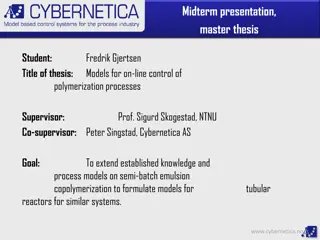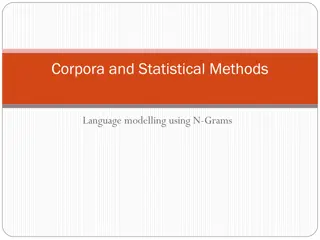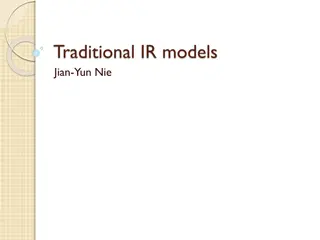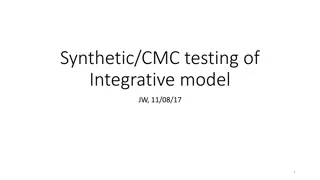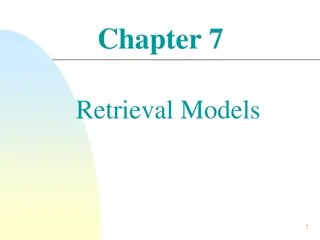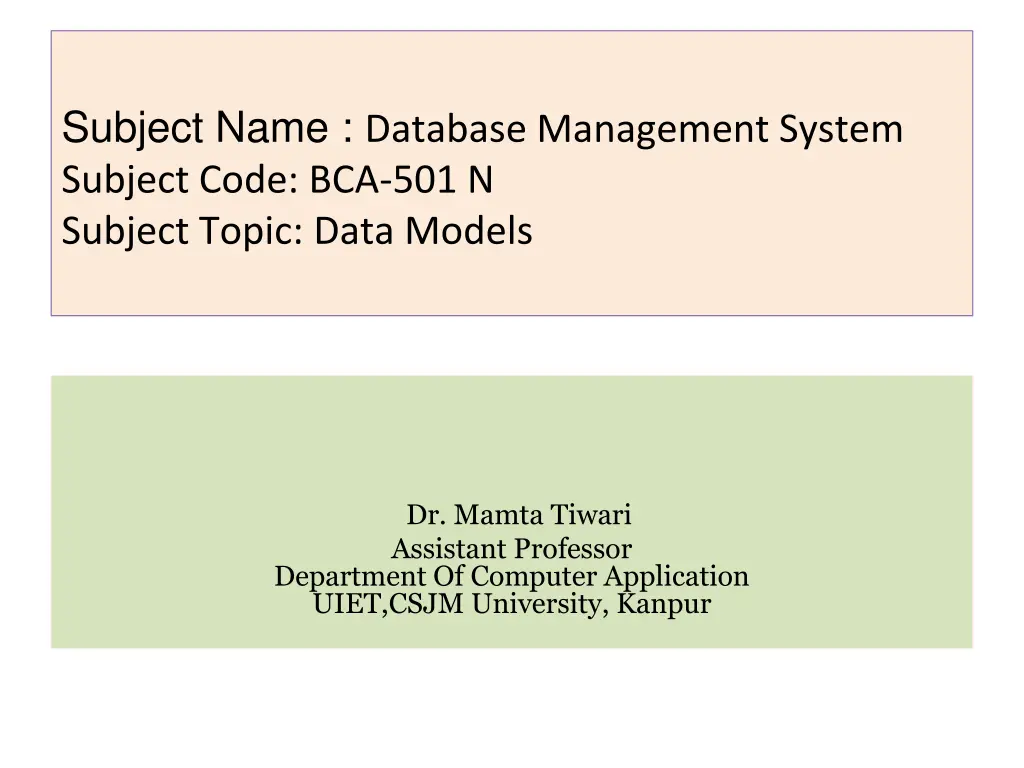
Understanding Data Models in Database Management Systems
Explore the objectives, types, and advantages of data models in database management systems. Learn about hierarchical and network models, their structures, and how they organize data efficiently for various users. Understand the advantages and disadvantages of hierarchical models in managing data effectively.
Download Presentation

Please find below an Image/Link to download the presentation.
The content on the website is provided AS IS for your information and personal use only. It may not be sold, licensed, or shared on other websites without obtaining consent from the author. If you encounter any issues during the download, it is possible that the publisher has removed the file from their server.
You are allowed to download the files provided on this website for personal or commercial use, subject to the condition that they are used lawfully. All files are the property of their respective owners.
The content on the website is provided AS IS for your information and personal use only. It may not be sold, licensed, or shared on other websites without obtaining consent from the author.
E N D
Presentation Transcript
Subject Name : Database Management System Subject Code: BCA-501 N Subject Topic: Data Models Dr. Mamta Tiwari Assistant Professor Department Of Computer Application UIET,CSJM University, Kanpur
Objectives of Data models Data model is a way of conceptually representation of structure of database. Structure of a database consist of data types, relationships and constraints that are applied on the data Facilitate interaction among the designer, the applications programmer, and the end user End-users have different views and needs for data,data model organizes data for various users
Types of Data Models Hierarchical Network Relational Entity relationship Object oriented
Hierarchical Model Developed in the 1960s to manage huge amount of data. Basic logical structure is represented by an tree The hierarchical structure contains levels, or segments
Hierarchical Model This database model organises data into a tree-like- structure, with a single root, to which all the other data is linked. The hierarchy starts from the Root data, and expands like a tree, adding child nodes to the parent nodes. In this model, a child node will only have a single parent node. This model efficiently describes many real-world relationships like index of a book, recipes etc. In hierarchical model, data is organised into tree-like structure with one-to-many relationship between two different types of data, for example, one department can have many courses, many professors and of-course many students.
Advantages and Disadvantages of Hierarchical Model Advantages Many of the hierarchical data models features formed the foundation for current data models. Data access is quite predictable in structure Parent child relation ship is one-to-many, it restricts a child segment to having one parent-segment Disadvantages Complex to implement Difficult to manage Implementation limitations
Network Model This is an extension of the Hierarchical model. In this model data is organised more like a graph, and are allowed to have more than one parent node. In this database model data is more related as more relationships are established in this database model. Also, as the data is more related, hence accessing the data is also easier and fast. This database model was used to map many-to-many data relationships. This was the most widely used database model, before Relational Model was introduced.
Advantages and disadvantages of Network Model Advantages It support multiple paths in the data structure eliminates some of the draw backs of the hierarchical data model. Disadvantages Too cumbersome The lack of ad hoc query capability put heavy pressure on programmers Any structural change in the database could produce lot of problem
Relational Model Data is organized in two-dimensional tables and the relationship is maintained by storing a common field. This model was introduced by E.F Codd in 1970, and since then it has been the most widely used database model. The basic structure of data in the relational model is tables All the information related to a particular type is stored in rows of that table. Tables are also known as relations in relational model.
Relational Model In the formal model, rows are called tuples Each column has a column header that gives an indication of the meaning of the data items in that column In the formal model, the column header is called an attribute name (or just attribute)
Entity Relationship Model The entity-relationship (E-R) data model perceives the real world as consisting of entities, and relationships among these objects. The E-R model is very useful in mapping the meanings and interactions of real-world enterprises onto a conceptual schema An ER model is a design or blueprint of a database that can later be implemented as a database. The main components of E-R model are: entity set and relationship set. basic objects, called
Entity Relationship Model The entity-relationship (E-R) data model perceives the real world as consisting of entities, and relationships among these objects. The E-R model is very useful in mapping the meanings and interactions of real-world enterprises onto a conceptual schema An ER model is a design or blueprint of a database that can later be implemented as a database. The main components of E-R model are: entity set and relationship set. basic objects, called
Relational Model The entity-relationship (E-R) data model perceives the real world as consisting of entities, and relationships among these objects. The E-R model is very useful in mapping the meanings and interactions of real-world enterprises onto a conceptual schema An ER model is a design or blueprint of a database that can later be implemented as a database. The main components of E-R model are: entity set and relationship set. basic objects, called
What is an Entity Relationship Diagram (ER Diagram)? An ER diagram shows the relationship among entity sets. An entity set is a group of similar entities and these entities can have attributes. In terms of DBMS, an entity is a table or attribute of a table in database, so by showing relationship among tables and their attributes, ER diagram shows the complete logical structure of a database.
Here are the geometric shapes and their meaning in an E-R Diagram. Rectangle: Represents Entity sets. Ellipses: Attributes Diamonds: Relationship Set Lines: They link attributes to Entity Sets and Entity sets to Relationship Set Double Ellipses: Multivalued Attributes Dashed Ellipses: Derived Attributes Double Rectangles: Weak Entity Sets Double Lines: Total participation of an entity in a relationship set
Components of a ER Diagram ER diagram has three main components: 1. Entity 2. Attribute 3. Relationship
References [1] https://www.tutorialspoint.com/dbms/dbms_overview.htm [2] [3] Fundamental of Database Systems by Elmasri/Navathe https://www.studytonight.com/dbms/database-model.php














